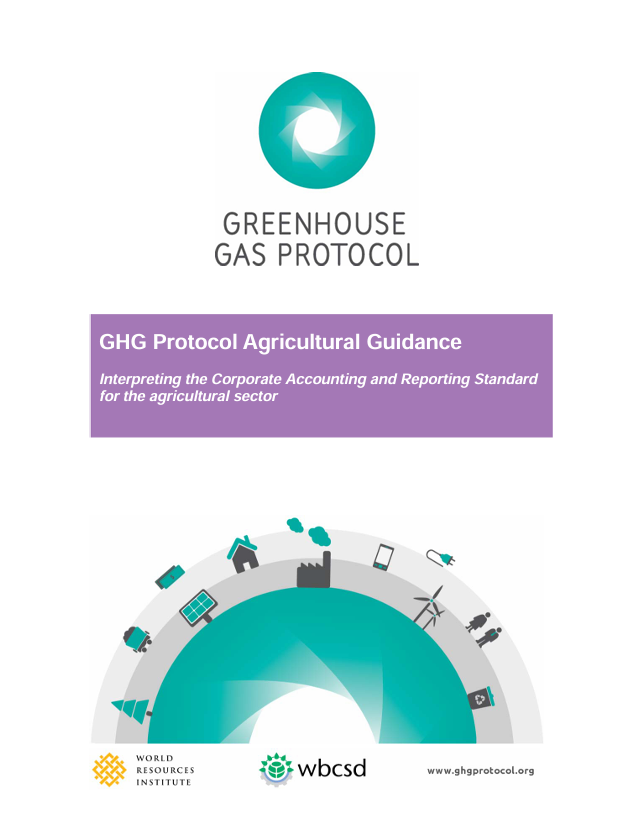
GHG protocol agricultural guidance: Interpreting the corporate accounting and reporting standard for the agricultural sector
The GHG protocol agricultural guidance provides a framework for agricultural companies to develop greenhouse gas (GHG) inventories aligned with the Corporate Standard. It offers sector-specific methodologies to account for direct and indirect emissions, carbon stock changes, and unique agricultural factors such as land use change and biological processes. The guidance enhances consistency, transparency, and usability of agricultural GHG data for decision-making and reporting.
Please login or join for free to read more.

OVERVIEW
GHG protocol agricultural guidance: Interpreting the corporate accounting and reporting standard for the agricultural sector
Chapter 1: Introduction
Agriculture contributes approximately 11% of global anthropogenic GHG emissions (2010), accounting for 50% of methane and 60% of nitrous oxide emissions. Including land use change (LUC), this contribution is significantly higher. The GHG Protocol Agricultural Guidance was developed to interpret the Corporate Standard for the agricultural sector and improve emissions accounting accuracy.
It addresses sector-specific challenges such as biological complexity, variability of environmental conditions, and delayed emissions from activities like residue decomposition. The guidance applies primarily to producers and companies creating scope 1 and 2 inventories, but is also relevant for upstream/downstream companies and policymakers.
Chapter 2: Business goals
The guidance supports multiple goals: identifying emissions reduction opportunities, setting and tracking targets, assessing risks, improving productivity, and enhancing market access. Measures like conservation tillage, cover crops, and anaerobic digesters can reduce emissions while offering agronomic benefits such as improved soil health, reduced input costs, and increased yields.
Chapter 3: Principles
Inventories must adhere to the principles of relevance, completeness, consistency, transparency, and accuracy. Due to inherent trade-offs, decisions should reflect business goals—e.g., less accurate but more complete data for initial assessments, and more accurate data for performance tracking.
Chapter 4: Overview of agricultural emission sources
Emissions sources are classified as mechanical (e.g., fuel use, refrigeration) and non-mechanical (e.g., enteric fermentation, manure management, soil amendments). Globally, non-mechanical sources dominate agricultural emissions, with enteric fermentation and soil N₂O as the largest contributors.
Chapter 5: Setting inventory boundaries
Organisational boundaries are defined using operational control, financial control, or equity share approaches. Operational boundaries classify sources into scope 1 (direct), scope 2 (indirect from purchased energy), and scope 3 (all other indirect). Scope 1 and 2 are mandatory; key scope 3 sources may also be reported. Special considerations are made for production contracts, leases, and co-operative structures.
Chapter 6: Tracking GHG fluxes over time
A base period must be established using the earliest verifiable data. Multi-year periods (e.g., 3-year averages) are recommended to reduce the effects of environmental variability. Rolling base periods may be adopted. Base period inventories must be recalculated when significant structural or methodological changes occur.
Chapter 7: Calculating GHG fluxes
GHG flux calculations depend on activity data and the chosen method: emission factors, empirical models, process-based models, or direct measurements. Non-mechanical sources have higher uncertainty. Key sources should be prioritised based on flux magnitude, uncertainty, and relevance. Tools should be selected based on their accuracy, transparency, and regional applicability.
Chapter 8: Accounting for carbon stocks
CO₂ fluxes from soil, woody biomass, and dead organic matter should be reported outside scopes in a ‘Biogenic Carbon’ category, unless due to LUC, in which case they are reported in scope 1. Fluxes may be amortised using a linear fixed-rate approach over time (typically 20 years). Historical LUC within the amortisation period should be included.
Chapter 9: Reporting GHG data
Required disclosures include base period rationale, emissions by scope and gas, and methodologies used. Best practice includes disaggregating emissions, reporting IPCC tier levels, and detailing amortisation methods and proxy assumptions. Scope 3 and avoided emissions are optional but encouraged where material. Emissions benefits from renewable energy sold off-site must not be netted against inventory totals.
Appendices
The appendices include performance metrics (e.g., per hectare, per product unit), amortisation case studies, and a detailed list of calculation tools, with coverage, geographic focus, and methodology noted. Allocation methods for multi-output farms are discussed, favouring physical or economic bases depending on context.


